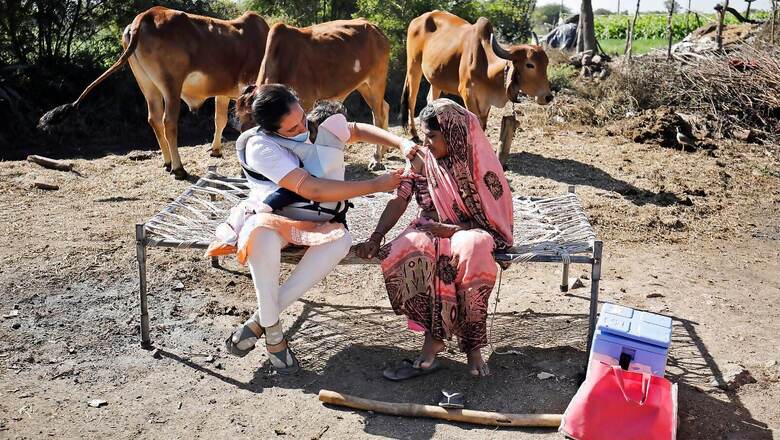
views
Amid new Covid-19 variants detected in India, the Centre on Wednesday reduced the booster dose gap to 6 months from its initial 9 months. The move, aimed at further increasing the population’s immunity against severe infections of the disease and hospitalisation, is being deemed as an encouraging one. However, ever since the booster drive kicked off in India, it has seen less recipients than expected, due to a variety of factors, according to experts.
But why is that? And why is a booster dose – a third vaccine shot taken after the second one – important? News18 explains:
Govt Data on Booster Vaccine Hesitancy, Other Studies
According to a government survey, there is more hesitancy towards booster doses in tier 2 and tier 3 cities compared to tier 1 cities. YouGov’s Omnibus collected data for this survey online from 1,013 urban respondents in India between June 14th and 17th, 2022, using YouGov’s panel.
What it found was that a higher proportion (74 per cent) of those who have received both doses of the vaccine are willing to take the booster dose without hesitation. Nearly one-fifth (18%) are hesitant to take another shot, while one-tenth are undecided (9 per cent). According to the survey, vaccine hesitancy appears to be higher in tier 2 and 3 cities than in tier 1 cities.
According to a separate study conducted by Mint, India has managed to administer only 32 boosters per 1,000 people, accounting for only 3% of the population. When compared to comparable emerging markets (EMs), China (547 doses), Brazil (500 doses), Mexico (408 doses), Indonesia (175 doses), and the Philippines (132 doses) are far ahead of India.
For a more detailed look on booster vaccine hesitancy, click here.
Why are People Hesitant About Booster Vaccine Doses?
Experts have detailed a number of reasons why India’s booster dose coverage is slow.
Confidence in 1st 2 Doses: The majority of respondents in the government survey mentioned earlier – 64 per cent – believe that the first two doses of the vaccine are sufficient, so they are hesitant to receive the precautionary dose.
Afraid of Short-term Effect: Some are also afraid of the short-term effects that getting a booster dose often invites: fever, bodyache, fatigue. People are also afraid of some of the rare long-term effects of a vaccine dose, documented in some studies and cases.
Skeptical of Booster Dose’s Effectiveness: Some people in urban India (15 per cent of respondents) are skeptical of the booster dose’s effectiveness.
Are these Reasons Justified?
The simple answer is no. The third booster dose has been well-documented to increase immunity against Covid-19, found waning after some months of taking the second shot.
The short-term side-effects of the booster dose also don’t necessarily mean one is ill. These simply show that the vaccine is building up the body’s immunity against the virus. And the long-term side effects of a vaccine dose are rare against the possibility of being severely effected by a Covid infection.
Why It’s Really Important to Get the Third Dose
The World Health Organisation has time and again warned that the pandemic ‘is far from over’. While the strains witnessed after the effects of devastating Delta mutant – which led the catastrophic second wave in India – have been relatively milder, there is no evidence to prove that future strains may not bring with them severe symptoms, which may require hospitalisation.
In the most recent development on the front, a new sub-lineage BA.2.75 of the Omicron variant of the coronavirus has been detected in countries like India and the WHO is following this, Director-General Tedros Adhanom Ghebreyesus said.
On Covid-19, globally reported cases have increased nearly 30 per cent over the past two weeks. Four out of six of the WHO sub-regions saw cases increase in the last week, Ghebreyesus said at a press briefing Wednesday. In Europe and America, BA.4 and BA.5 are driving waves. In countries like India a new sub-lineage of BA.2.75 has also been detected, which we’re following, he said. On the emergence of the potential Omicron sub-variant BA.2.75, WHO Chief Scientist Soumya Swaminathan said in a video posted on Twitter that there has been an emergence of a sub-variant that is being called the BA.2.75 first reported from India and then from about 10 other countries.
She said there are still limited sequences available of the sub-variant to analyse, but this sub-variant seems to have a few mutations on the receptor-binding domain of the spike protein. So obviously, that’s a key part of the virus that attaches itself to the human receptor. So we have to watch that. It’s still too early to know if this sub-variant has properties of additional immune evasion or indeed of being more clinically severe. We don’t know that.”
Read all the Latest News, Breaking News, watch Top Videos and Live TV here.




















Comments
0 comment